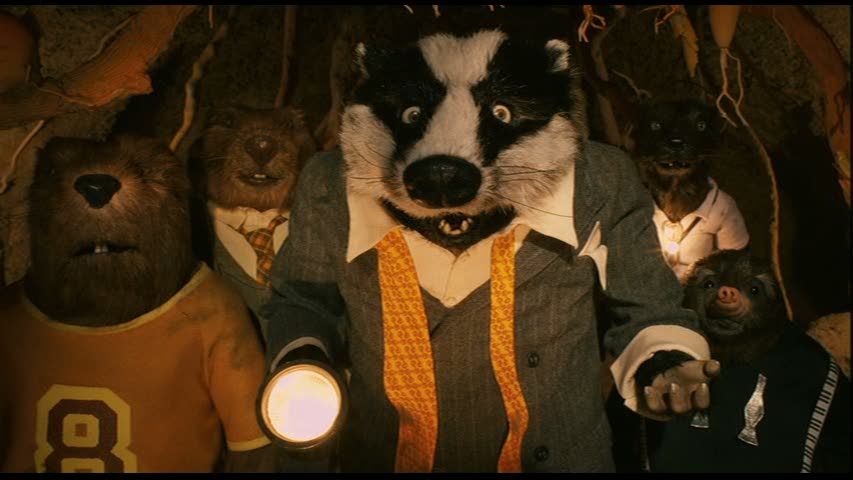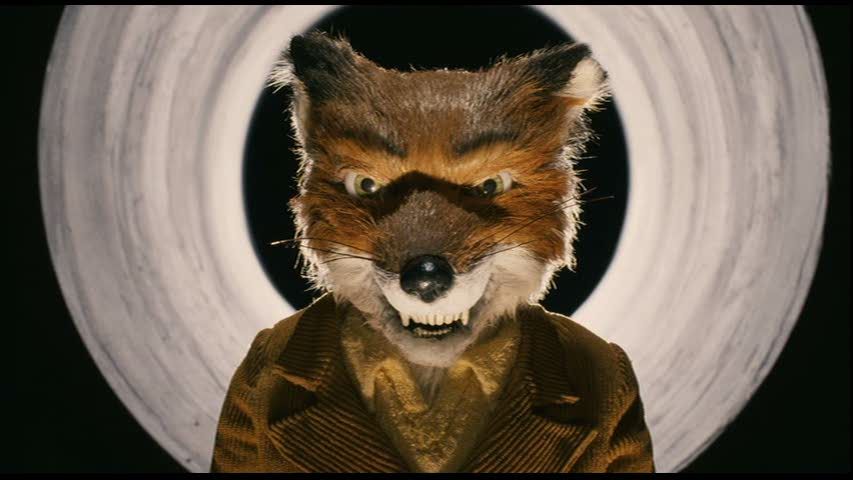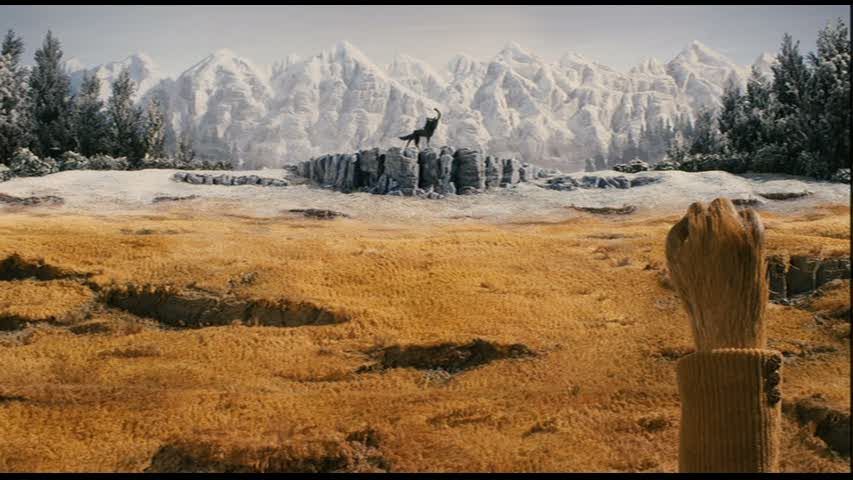
Wes Anderson's adaptation of Roald Dahl's children's book The Fantastic Mr. Fox is bursting with delight and wit. It is not necessarily a children's film but a film made with a child's sensibility, a child's sheer pleasure in images and stories. It is playful, inventive, irreverent, packed with moments of offbeat humor, surprising pathos and warmth. It is stitched together from various familiar stories and tropes — our differences make us special, family is important, even some borrowings from genre fiction's obsession with the criminal's perennial "one last score" — and it tries to make something magical and fresh from these well-worn ideas. It largely succeeds. The film is alive with a communitarian spirit, with the genuine celebration of quirky, unusual individuals and the ways in which they fit together, sometimes awkwardly, as a larger group. It's a film about family relationships, about struggling against or towards one's true nature, about modernity's distance from the natural world. And all of this with a cast consisting of stop-motion foxes, badgers and opossums.
Though this is Anderson's first animated film, thus setting it apart from his other work, it never feels like anything but an Anderson film. To some extent, this is because Anderson has been steadily moving towards a place where an animated film like this fits perfectly into his oeuvre. Certainly, he's always been interested in creating artificial, stylized worlds with little connection to tangible reality beyond the recognizable and understated emotions of his characters. His detail-oriented aesthetic makes him as much a designer as a filmmaker: his films are always packed with bric-à-brac and accessories, with the objects that surround and define his characters. Paintings, books, furniture, and other decorative touches are routes into characterization, as well as being displayed simply for low-key humor. The cutaway views of Steve Zissou's ship in The Life Aquatic — as well as the animated underwater scenes in that film — thus seem like a preparation for Anderson's complete embrace of the animated aesthetic, with multiple cutaways, in The Fantastic Mr. Fox.

This approach is perfectly suited to the children's book storytelling of The Fantastic Mr. Fox. The film's anthropomorphic animals inhabit a world of bright, autumnal colors, the golden-hued images seemingly coming right out of a picture book. Within this world, the characters are often weirdly overwhelmed in the compositions, trotting around like tiny action figures, leaping across the frame and darting through the maze-like routes that Anderson plots out through many of the scenes. He often cuts back to a wide shot that shows the whole set in cutaway, so that the characters look like moving dolls in a very elaborate children's toy set-up. This sense of play is endearing and infectious; it gives the impression that Anderson is letting us in on his private fantasies, the stories he invents for his personal collection of animal action figures.
Among this cast of toy animals is the title Mr. Fox (voiced by George Clooney), an excitement-loving predator who preys on chicken farms and exalts in the thrill of the hunt, or rather the break-in in his case. Anderson cleverly models him, not on a children's book hero, but on the movie stereotype of the aging crook trying to go straight, but tempted to do one last job because of the excitement. Fox's life of crime is ended when his wife, Mrs. Fox (Meryl Streep) announces that she's pregnant, and that she doesn't want this risky life anymore. Instead, Fox becomes a newspaper columnist, settling down as the couple has a new son, Ash (Jason Schwartzman). The Fox family is relatively content, but their life is too simple for the family's father, who considers himself a self-styled adventurer. In this respect, the casting of George Clooney is an act of genius, since his instantly recognizable voice gives Mr. Fox the persona of a real smooth operator, a real glamorous daredevil in the mold of Clooney's Daniel Ocean. He even has a stylized signature move — a whistle, a snap and a hand gesture — a sign both of his cool and the lengths he goes to maintain his image. His is not an effortless cool, it's very deliberate and very self-aware, much like Anderson's own self-conscious aesthetic.

The core of Anderson's film follows the plot of the Dahl novel, as Fox, together with his dopey opossum landlord Kylie (Wallace Wolodarsky), plots to steal from the three nasty local farmers Bean (Michael Gambon), Boggis (Robin Hurlstone) and Bunce (Hugo Guinness). The caper scenes recall both Anderson's debut Bottle Rocket and the action scenes in The Life Aquatic, precisely tracing out of the path of the action and chronicling the combination of careful planning and in-the-moment improvisation that goes into the Fox's plans. Anderson's finicky aesthetic is perfectly suited to sequences like this, as his eye for detail ensures that every piece fits together. The animation is perfectly attuned to Anderson's style, as well, with a jerky varying of rhythms and speeds that gives the characters a restless energy. They sometimes seem to be hurtling around Anderson's obstacle course sets like they're in a pinball machine, and they can unpredictably burst from stasis to action at any moment. At other times, the set cleverly allows for disjunctions where the characters can move fluidly across a large distance within a second, so that the characters' motion substitutes for a conventional cut.
Also typical of Anderson is the way he deals with the story's emotions, which are large and up-front, befitting a children's story, but are treated with an understated subtlety that makes these characters more poignant and complex than they otherwise would be. The biggest themes of the story are, as often as not, stated outright, so there's no question about what's at stake here: the constant desire for more from life; the tradeoff between simple contentment and a vibrant, exciting life; the complications of family. The Fox son, Ash, is a typical Anderson eccentric outcast; he wants to fit in, wants to be considered "an athlete" like his cool and popular dad, in whose shadow he constantly resides. But instead he's shy and awkward, and finds that his dad dotes more attention on Ash's visiting cousin Kristofferson (voiced by Anderson's own brother Eric). Kristofferson is sleek and stylish like Mr. Fox himself, naturally talented and athletic, and he's incorporated into Fox's schemes and plans almost as soon as he arrives, while Ash, eager to be accepted, gets pushed aside. These tensions are right up front, but the expressiveness of the character design and animation infuses these characters with deeper emotional substance below the surface. It's all in the body language, and the characters' watery, alive eyes, highlighted in closeups where the light glistens on the hint of tears threatening to well up in the corners of their eyes. The subtlety of the animation, and the performances of the voice actors, helps enrich their emotional arcs.

Indeed, from Clooney's suave cool to Streep's even-keeled warmth to Willem Dafoe's sinister rat gangster to Bill Murray's badger lawyer, the cast is uniformly excellent, creating a vibrant and living community. That community is at the film's heart, the idea that all these different creatures, each defined by their natural talents and attributes, their disparate personalities, add up to a whole greater than the sum of the parts. It's a typical children's movie theme, delivered with Anderson's usual panache and cleverness. More than anything, it's an unremittingly fun movie. It's never less than a blast to watch, especially when these cool and collected animals unexpectedly betray their animal natures with outbursts of frenzied growling and snorting, or tear apart a plate of food in a spate of hunger. Anderson has made a sweet, smart fantasy, a pure celebration of eccentricity and style. In the end, his idiosyncratic characters make a place for themselves in the modern world by reconciling themselves to compromise, to cooperation, to new ways of doing things.

7 comments:
Some have categorized this as a kind of HOBBIT or WATERSHIP DOWN with an irreverant slant. But as you clarify most acutely in your excellent opening paragraph it's really none of the sort. It's about family and "communitarian" spirit. (the second word you choose there is great)
The incomparable Mr. Dahl is my personal favorite children's writer, so revered in fact that I once staged a grammar school production of CHARLIE AND THE CHOCOLATE FACTORY in one of our district's grammar schools. His sardonic wit and irreverence are his trademarks, but he's quite a perceptive and humane guy as well, and he imparts in his novel of this film vivid portraits, the verbal equivalents of the illustrated success of William Steig.
I found the film lost some steam in the final third, after what you superbly assert where it became a bit tiresome and redundant, and less pointed:
"The animation is perfectly attuned to Anderson's style, as well, with a jerky varying of rhythms and speeds that gives the characters a restless energy."
Clooney's voice is undoubtably marvelous as are several others here.
In the pantheon of 2009 animation, this is the second best behind Pixar's UP, as that sublime work is a deeply moving examination of the life cycle that exerts strong after-viewing resonance. FANTASTIC MR. FOX though is a spirited work, which takes the animation experience to a cerebral level, certainly a rarity these days.
It's a perfect wedding of Dahl and Anderson for more than one reason.
What I love about it most is that it's so completely anti-PIXAR. The animatio0n isn't slick. It's delightfully hery-jerky -- thus engaging our consciousness as computer animation never does.
Mr. Fox is a variation on Royal Tenenbaum. Clooney is more Clooney than ever, and I especially liked Jason Schwartzman's ever-resentful Ash.
Thanks, Sam. I don't really agree that the film ever lost steam, I was charmed and entertained the whole way through, and thought the ending, with its visual tribute to the Peanuts TV specials, was fantastic and moving.
On the other hand, I haven't seen Up but in general I agree with David that I much prefer the ragged, loose-limbed aesthetic of this film to Pixar's slick, too-often-bland CGI surfaces. I like animation with some grit and verve, and the herky-jerky stop-motion style is well-suited to this film's tone.
I also agree that Schwartzman's Ash is especially great. I love the scene where he abruptly pops up into the frame, seeming to break the fourth wall by addressing the camera, but his dad's head poking out from behind him then reveals that he's not turning towards the audience but simply away from his dismissive, distant father.
I'm glad you wrote about this one, Ed. That waterfall image reminded me of Michael Mann's little-discussed influence on Anderson -- very "Last of the Mohicans." Maybe it's coincidental, but with the many Mann allusions that run through his films (e.g., Max and Dirk buying munitions for their big Vietnam play is a homage to an early scene in Heat), I doubt it. Violence, in general, is an interesting subject in Anderson's movies. "Fantastic Mr. Fox" is relatively violent, at least by the standards of the genre.
Interesting, Craig. I wouldn't have thought of the Mann influence myself, but that image does seem resonant in that direction now that I think of it. And yes, all throughout this film I kept thinking how strange it was that Anderson was dealing with these children's book themes and stories in a way that often seemed defiantly anti-kid-friendly. The violence is stylized and consciously refers to genre cliches, like the rat's drawn-out death scene and redemption, neatly topped by a flat statement that it was his redemption, in case we missed it. Even so, some of the violence hits surprisingly hard, especially all the grisly dark comedy involving Fox's tail.
Ed,
I'm soliciting bloggers' favorites (of their own posts) for my year-end round-up at The Dancing Image. Here's the explanation (with a bit of a mea culpa):
http://thesunsnotyellow.blogspot.com/2009/12/best-of-blogosphere.html
Feel free to leave your own selection there - links to all submissions will be posted around the 30th, but I'll certainly be taking them after that too.
Thanks & happy new year!
P.S. This is especially tough with your blog, given the sheer volume of your writing! I can't wait to see what you pick...
I finally got over here to read this, and it's another great review. Your enthusiasm for the film shines through here -- it's obvious that it was a fun experience for you as you watched and wrote about it.
One thing I forgot to write about when I reviewed it, but that stood out to me when watching, is about the wide-shot cutaways (that you give mention to). Anderson uses those quite well throughout the film and to great effect. That was an especially nice touch for both efficient storytelling and creating a signature style.
Really, I could just keep going about this, but you read my review and know my love for the film. It was great reading such a glowing review over here, as well.
Post a Comment